Biography
Interests
Cletus Ukwubile, A.*1, Jude Odugu, A.2 & Mathias Bingari, S.3
1Medicinal Plants Research Laboratory, Central Academic Center / Sancta Maria Clinic Integrated Laboratory Bali, Taraba State, Nigeria.
2Department of Medical Microbiology Ahmadu Bello University Teaching Hospital, Shika, Kaduna State, Nigeria.
3Department of Biological Sciences, Taraba State University Jalingo, Nigeria.
*Correspondence to: Cletus Ukwubile, A., Researcher FPB, Department of Molecular Biology, Sancta Maria Clinic Integrated Laboratory Bali, Nigeria.
Copyright © 2018 Cletus Ukwubile, A., et al. This is an open access article distributed under the Creative Commons Attribution License, which permits unrestricted use, distribution, and reproduction in any medium, provided the original work is properly cited.
Abstract
In this study, LD50 (Acute toxicity) values of methanol extract of leaves and stembarks of Annona senegalensis was determined using the methods of Lorke’s (1983) as well as phytoconstituents and anthelminthic activity of the leaf and stembark extracts. Dried powdered leaves and stembark of A. senegalensis were extracted using methanol as the solvent. Phytochemical screening of the two parts revealed mainly glycosides and alkaloids. Acute toxicity (LD50¬) test was performed with the leaf and stembark extracts at doses of 10, 100, 1000mg/kg b.w (body weight) in phase I and 1600, 2900 and 5000mg/kg b.w in phase II , administered to the mice i.p (intra-peritoneal). The animals were grouped into three groups of 3 mice per group in phases I and three groups of one mouse per group in phase II. They were observed for behavioural changes and mortality for one week. There were decreases in the body weights of the mice administered with leaf and stembark extract as the doses increased but no mortality was recorded in phase I up to 1000mg/kg b.w. In phase II, there was no mortality up to the dose of 5000mg/kg b.w. Anthelminthic activity of the plant was displayed greatly in dose-dependent fashion with shorter time of paralysis and time of death in stembark extract than in leaf extract against earthworms. This result was compared with a standard anthelminthic drug Piperazine citrate at p≤0.05 (one-way ANOVA). The result showed that the leaf and stembark extracts of A. senegalensis are very safe at the doses investigated and justifies its use as an oral medication in traditional medicine as an anthelminthic agent or worm expeller.
Introduction
The diversity of forest especially in plant life is an essential assets to both humans and animals as they depend directly or indirectly on these forests for survivals [1]. Humans currently use tens of thousands of plant species for multiple purpose such as food, fuel, fibres, oil, forage and medicine forest ecosystem renders services of industrial, pharmaceutical, cultural and socio-economic important to man contribution to the world economy in the tropic alone. It has been estimated that 25000 plants species are used in traditional medicines [2].
Medicinal plants are of great importance to the health of individuals and communities, many of these indigenous medicinal plant are used as species and food plants. Today, most pharmaceutical drugs are derived from excellent ingredients in medicinal plants in folk medicine, many natural raw drugs have the potential to treat many diseases and disorders, one of which is Annona senegalensis. A. senegalensis is commonly known as African custard apple, wild custard apple and wild soursop is a species of flowering plant in the custard apple family of (Annonaceae). The specific epithet “senegalensis” translates to means of “Senegal” common vernacular name are “Uburu Ocha” (Igbo) “Gwander daajii” (Hausa) “Arrere” or “abo” (Yoruba).
A traditional food plant in Africa, the fruits of A. senegalensis have the potential to improve nutrition, well known where it grows naturally. The plant is used in folk medicine for the treatment of several ailments like guinea worm, diarrhoea, snake bites, headache and respiratory tract infection. The leave are used in sealing curs and wounds [3]. Many medicinal plants used traditional in treatment of different ailment, have been in use by man without the actual knowledge of their toxicological. In view of these we set to study the acute toxicity of the leaves and stem bark using experimental animals. The purpose of acute toxicity test is to obtain information on the biological activity of A. senegalensis into its mechanism of action.
A. senegalensis tends to grow in semiarid to sub-humid regions. It is also found in the Savannah parts of tropical rain forest island of Sudan and South Africa, often but not exclusively on coastal based rock’s with mostly sandy loamy soils from sea level up to 2400 m at mean rainfall solitary plants within woodland savannah understory also frequently in swamp forests or river banks or on former cropland left fallow for an extended period [4].
Annona senegalensis takes the form of their a shrub or small tree growing between 2-6m tall occasionally; it may become as tall as 11m. it has bark of smooth or coarse texture that can be a grey-silver or grey-brown it is leaf scarred, with nearly round flaking showing lighter hued spaces of under bark. Branches have thick grey, brown or yellow tomentum when new but this is later shed with age. The green to blue-green leave are alternate simple oblong to ovate to elliptic from 6-18 long by 2.5 - 11.5cm wide, with upper sides, green to reddish veins on both surface with rounded to slightly notched optics. The leaf base is squared or barely “lobelia”. The leaf margin is entire stout peptides are 0.5 in dash 2.5cm long.
Flowers mature to up to 3cm in diameter on 2cm stalks, either singular, or two to four ascending from the leaf axils. Six thick, creamy or xanthenes petals display in double whorls and green on the outside, but either creamy or sanguine within, each is roughly 0.8 - 1.5 by 0.9 - 1.1cm, hairless or somewhat fuzzy petals inner whorls curve over it stamens and ovary, three loose sepals are oval and smaller than the petals (3-4) by (4-5mm). the stamens range from 1.7 to 2.5mm in length [5]. Fruits are formed of numerous fused fleshy, bumpy, oviform or globular carpel about 2.5 - 5 by 2.5 - 4cm. they are green when young, ripening to yellow, and naturally to orange, packed with many burnt- orange colored, oblong, cylindrical seeds. The fruit stalk is 1.5 - 5cm in length. A. senegalensis is generally pollinated by several species of beetle but can be hand pollinated when grown as a crop plant, its seeds viability usually last not more than 6 months.
The primary use of this versatile plant is for food but it has application in numerous aspects of human endeavours and every part of the plant has unique properties and uses [6]. The flowers, leaves and fruits are edible and culinary white fruit pulp has a mild pineapples like flavor flowers are added to spice or garnish meals, leaves are eaten by human as vegetables or browsed by livestock leaves are also part of the diet of the West African. The leaves are also used to create a general health tonic in the treatment of pneumonia and as mattress and pillow stuffing. Specific to Sudan, leaves are boiled in the making of perfume. Bark can be processed to produce yellow brown dye, insecticide, or medicine for treating a wide arrays of ailments, including worms parasitic on the intestine or flesh (Notably guinea worms), diarrheal, gastroenteritis, lung infections, tooth aches. Natural gum in the bark is used to close open wounds [7].
A. senegalensis is also traditional in the treatment of snake bites and in the treatment of sleeping sickness in Northern Nigeria. It is used in the treatment of skin or eye disorder. Roots are also used medicinally in treating a gamut of condition, from dizziness and indigestion to chest colds to venereal diseases. Suckering shoots provide binding fibres and the malleable pale brown to white wood is used to carve tools handles or fashioned into poles wood ash is an admixture to chewing, and also in soap production as solvent the essential oil in the fruits and leaves are valued for their organic chemical constituents. A. senegalensis has been reported to have antibacterial activity. The trypanocidal activity have been investigated [8].
The preliminary phytochemical analysis of Annona senegalensis showed the presence of steroids and/ or triterpenes, anthocyanin glycosides, coumarins, flavonoids and alkaloids. Gas Chromatography/mass spectrometry (GC/MS) of stembark of A. senegalensis also showed the presence of 1,2-benzenediol, bulylated hydroxytoluene (BHT), phenol 2,6-bis-1,1-diethyl-4-methyl, methyl carbonate n-hexadecanoic acid, hexadecane, 13-hexyloxacyclotride-10-en-2-one, oleic acid tetracosane, 12-methyl-E, E.2, 13-octadecadien- 1-ol octadecanoic acid, 9,17-octadecandienal, pentadecane, tetriacontane and squalen [9].
This present study was carried out in order to determine the phytoconstituents, anthelminthic and acute toxicity study of Annona senegalensis leaf and stembark methanol extract.
Materials and Methods
The leaves and stembarks of A. senegalensis Pers. was initial collected from the plant in the a forest at Sabondale
Bali, Taraba State Nigeria, and identified at the Science Laboratory Technology (SLT) Department of
Federal Polytechnic Bali by Mr. Cletus A. Ukwubile; where a voucher number of FEDPOBALI2014ANN002
was deposited for the plant.
The plant material was air dried at room temperature for 2 weeks and was pulverized into coarse powder using an electronic blender. The powder was then sieved using sieve number 20 mesh to obtain a fine powder which is referred to as plant material and was weighed. The plant material was kept in a cleared and dried desiccator for further use.
200g of leaf and stembark powdered plant material were taken into different separating funnels and soaked with 400mL of methanol mixed with 200 m of distilled water at room temperature for 24 hours using cold maceration technique. The same was done to the stem bark, the extract were filtered through Buchner funnelusing Whatman No 1 filter paper. The filtrates were evaporated on water bath at 64 OC. The extract was weighed and percentage yield calculated.
Preliminary phytochemical screening was carried out using method described by [10]. Each extract was screened for the presence of alkaloids, flavonoids, carbohydrates, tannins, steroids, triterpenes, and other metabolites.
Acute toxicity study of the leave and stem bark of Annona senegalensis was carried out according to the method of Lorke [11]. 26 Swill Albino mice of weights between 27.0 and 43.0g were allowed to acclimatized for 24 hour. In the first phase, mice were divided into three groups of three animals each and were treated with the extract at doses of 10, 100 and 1000mg/kg body weight i.p (intra-peritoneal). They were observed for 24 hour for behavioural changes and mortality for one week.
In the second phase, mice were further divided into three groups of one mouse per group and were also administered with the extract doses of 1600, 2900 and 5000mg/kg body weight i.p and observed for another one week for mortality and general behavioural changes. The LD50 was calculated as geometric means of the highest non-lethal does (with no death). That is:

The anthelminthic activity of stem leaf and bark extracts of A. senegalensis as per as the method reported by [12-16]. Briefly, seven groups of earthworm (Lumbricus terrestris) with four worms in each group. Each worms were separated into 10mL of desired formulation in normal saline. The earthworm used was because of their similar physiology and body anatomy with intestinal parasitic worm.
Group I earthworms were released into 10mL normal saline in a clean Petri dish and were maintained as negative control.
Group II earthworms were release in normal saline containing standard drug Piperazine citrate (B.P.C Elixir) 10mg/mL as positive control.
Group III, IV, V, VI and VII earthworms were released in 10, 20, 30, 40 and 50mg/mL of extracts in 10mL normal saline respectively.
Earthworms were observed for time of paralysis and death. Paralysis was observed based on the behaviour of the worm with no revival of body state. Death was concluded based on the total loss of motility with faded body colour [17]. The experiment was repeated for each group four times and mean values were recorded.
The data obtained were expressed as mean ± SEM of four earthworm in each group. Statistical analysis
was carried out using one way ANOVA. The difference in values at p<0.05 was considered as statistically
significant. Analysis of variance (ANOVA) was performed using SPSS (Version 22) software to determine
the mean and standard error in time of paralysis and death of earthworms.
Results and Discussion
The use of medicinal plants to manage ailment is very common especially in rural areas of Nigeria where
about 70 % of the populace reside. Preparations of Annona senegalensis are used in the management of
a wide range of ailments ranging from gastrointestinal disturbances, central nervous system disorders to
cancer. The importance of the plant in folk medicine its popularity and high demand as well as its promising
pharmacological potentials make this toxicological studies on its imperative. To determine the safety of
drugs and plants products for human use, toxicological evaluation is carried out in various experimental
animal to predict toxicity and to provide guidelines for selecting a safe dose in humans.
Toxicity test are generally the first test conducted in any toxicity study, a summary of the result of the mortality and gross symptoms of toxicity seen in mice administered i.p (Intra-peritoneal) with the extract of leave and stem bark of Annona senegalensis. There was no noticeable deviation in the behaviour of mice administered i.p with 10,100, 1000, 1600, 2900 and 5000mg/kg compared to that of the control all the dosed mice remained healthy during the 2 weeks. There was decrease in the body weight of the mice, the animals use in the study were fed with normal mice diet. The acute lethality, LD50 of the extracts indicate a relatively high safety profile.
Meanwhile, the phytochemical screening of the leaf shows the highly present in alkaloids, flavonoids, present in the carbohydrates, tannins and absent in steroids while the stem bark extract show highly present in alkaloids; flavonoids, saponins, carbohydrates, tannins and steroids (Table 1).
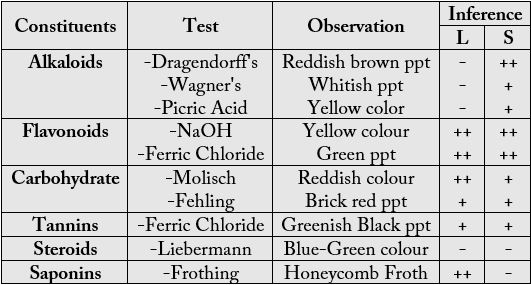
++ (highly present), +(moderately present), -(Absent)
The observed decreases in body weights of the mice may be due slight toxic effects of the extracts especially the stembarks on some vital organs of the animals (Table 2).
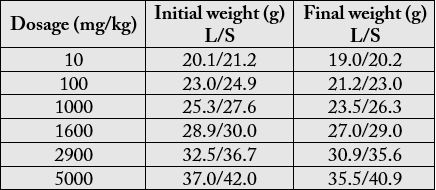
* L (leaf extract), S (stembark extract)
However, these decrease were not synonymous to major toxicological parameters [18-20]. There were no observed toxicity with the 5000mg/kg dose which could be ascribed to a particular constituent . The variations in the degree of presence of these phytochemicals in the extract may have been responsible for the different lethality values exhibited by the extract, though they all manifested high level of safety (Tables 3 and 4).
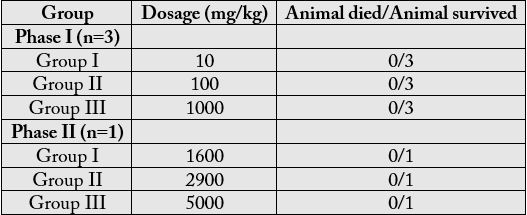
*LD50 > 5000mg/kg b.w [biological unimportant; [10]
Table 4 also shows the result of the acute toxicity study (LD50) of A. senegalensis stem bark. There was no death up to the dose of 5000mg/kg body weight. However, there was partial decrease in activity of the mice which lasted few minutes after administration of A. senegalensis extract.
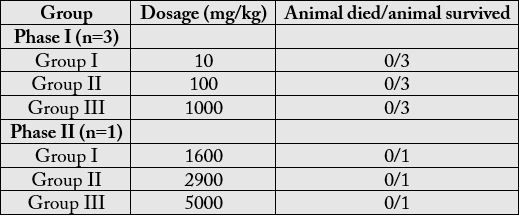
*LD50 > 5000mg/kg b.w [biological unimportant; [10]
The plant parts displayed high degree of anthelminthic activity against earthworm with the stembark showing the best activity (Tables 5 and 6). This result justifies the use of the stembark extract as an excellent worm expeller as opposed to leaf extract. However, both plant parts showed significant anthelminthic activity.
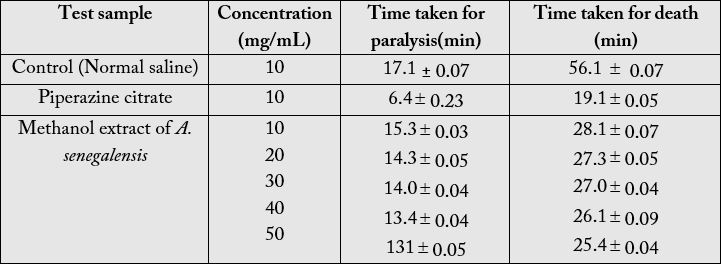
Results are means ± S.E.M at n = 4

Results are means ± S.E.M at n = 4
Conclusion
The leaves and stem bark extract of A. senegalensis possesses no obvious significant toxic effects even at 5000mg/kg dose. This overall findings buttress the fact that local dwellers in different parts of the savannah and
rainforest zones of northern Nigeria have been using parts of A. senegalensis for medicinal purpose and the
juicy fruit are edible for many years without obvious complaints of toxicity. The study therefore showed that
A. senegalensis extracts is very safe ethnomedicinal prescription in the treatment and management of various
ailments in traditional medicine such as worm expeller.
Acknowledgement
The authors are grateful to Malam Shuabu Takalafia, Miss Blessing and Mr. John Victor who helped us
during this study.
Bibliography

Hi!
We're here to answer your questions!
Send us a message via Whatsapp, and we'll reply the moment we're available!